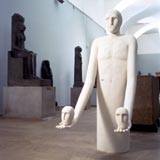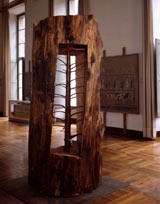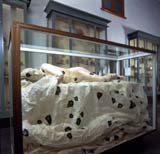| Time Machine - Ancient Egypt and Contemporary Art An exhibition at the Museo Egizio, Turin. 14 December 1995 - 31 March 1996 with Francesco Clemente, Stephen Cox, Brian Eno, Andy Goldsworthy, David Hiscox, Jiri Kolar, Igor Mitoraj, Mimmo Paladino, Giuseppe Penone, Marc Quinn, Peter Randall-Page, Martin Riches, Kiki Smith, Kan Yasuda. The Museo Egizio was among the first truly great collections of Egyptian antiquities to be set up in an era when just the sight of such exotic and ancient artefacts was enough to inspire and amaze its visitors. To a more worldly modern audience museums tend to be viewed as insular places that lack any spontaneity or connection with the present. Yet there is a growing world-wide movement within curatorial circles to explore new ways of show-casing collections and of placing contemporary art in unlikely but more 'accessible' public venues. The recent Time Machine exhibition at the British Museum was seen by over a million people and had the advantage of attracting a whole new audience both to Ancient Egyptian and Contemporary Art. It attracted considerable enthusiasm and debate in both the art and museum world since it raised fundamental questions about the relationship between the museum and its public. The installation of works by living artists in the galleries really changes the way we perceive our permanent collections, opening new avenues for viewing them in a fresh, more aesthetic light rather than as mere archaeological documents of a dead civilisation. When viewing the impressive Ancient Egyptian stone statues we cannot avoid feeling a sense of the enormous passage of time. The Egyptians were very aware of both linear and cyclical time. They were the first to divide the year into 365 days, the day into 24 hours and devise the earliest sun and water clocks. Their finest sculpture conveys a feeling of serenity, retaining all of its of power through the passage of thousands of years. In the Ancient Egyptian language, the expression for a sculptor, was 'he who keeps alive' and visual representation was closely linked to magic and ritual and a divine order of all living things. Statues were regarded as receptacles for this divine force and to the ancient Egyptians, art was a magical means of harnessing the energy they observed in nature's great cycle of birth, death and rebirth. Duality and balance are notable features of Ancient Egyptian art while the imitation of the creative power of nature conveys a deep understanding of human destiny. This quality of permanence and continuity makes the juxtaposition of work by living artists all the more appropriate as a means of 'recharging' the ancient pieces. Instead of including work by artists that merely pastiche Ancient Egyptian forms and iconography it was thought that a far more interesting and varied show could be made by installing art that relates to the antiquities in an intuitive and less direct way. It was also important not to represent only one 'school' of contemporary art but to feature a more varied selection of artists to express their thoughts in unique ways. Although stylistically the contemporary work is somewhat diverse there is a subtle unifying factor and great care has been taken to ensure that the contemporary work is not too invasive on the antiquities. Rather than a mere contrast between the ancient and modern Time Machine is an exploration of the dialogue and harmony between them. This offers a challenging and thought provoking insight into the creative mind of human beings unbound by time. James Putnam, Curator of 'Time Machine 2', Turin, 1995 To download edited video clip from BM Education video click here |
 |
||
| Mimmo Paladino - Senso titolo, Vicenza stone, 1993. |
|||
 |
|||
| Guiseppe Penone - Tree-door, cedar, 1995. |
|||
 |
|||
| Kiki Smith - Southern Hemisphere Constellation,
tissue-paper and cellulose lacquer, 1995. |
|||
 |
|||
| Kan Yusada - Shinsei and Seitan, bronze, 1985.
|
|||